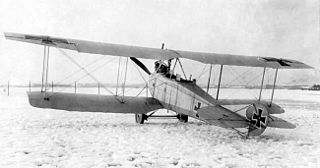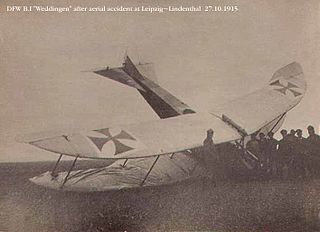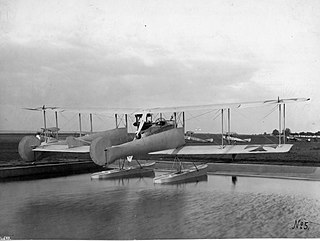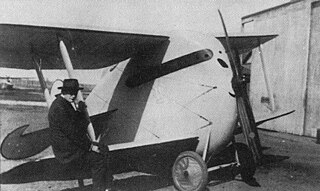
The AEG C.VIII was a prototype two-seat reconnaissance aircraft of World War I. Two examples were built, based on the successful C.IV design, one of biplane configuration, the other a triplane. Neither version offered enough of an improvement on the C.IV to make mass production worthwhile.

The Aviatik C.I was an observation aircraft which came into service during World War I in April 1915. It was a development of the Aviatik B.I and B.II models, being one of first aircraft of the new German C class of armed biplanes. In the C.I the observer sat in front of the pilot, with a machine-gun clipped on a sliding mounting fitted on a rail at either side of the cockpit. It gave the crew the means to attack enemy aircraft. The positions of the pilot and observer were reversed in last series of 50, ordered in 1917 solely for trainer purpose. There was only one aircraft built of refined C.Ia version in May 1916, with armament still in a forward cab, serving as a prototype for C.III. Later models of the plane included the Aviatik C.II and the C.III, which had more powerful engines. The C.III was produced in large numbers.

The Albatros W.4 was a German floatplane derivative of the Albatros D.I fighter with new wing and tail surfaces of greater span than the D.I. One hundred eighteen examples were built between June 1916 and December 1917. The aircraft operated in the North Sea and Baltic theatres and later served as training aircraft.

The Albatros D.XII was a German single-seat fighter biplane first flown in March 1918. It was the last of the Albatros fighters completed and flown before the end of World War I and had the same slab-sided fuselage seen on the Albatros D.X.

The DFW B.I, was one of the earliest German aircraft to see service during World War I, and one of the numerous "B-class" unarmed, two-seat observation biplanes of the German military in 1914, but with a distinctive appearance that differentiated it from contemporaries. Though a biplane, its crescent-planform three-bay wings were inspired by that of the earlier Rumpler Taube monoplane, and led to the DFW aircraft being named the Fliegende Banane by its pilots.

The Pfalz D.VIII was a German World War I fighter aircraft.

The Fokker D.IV was a German fighter biplane of World War I, a development of the D.I.

The DFW Mars was an early German military utility aircraft built in 1913 and was the first original design manufactured by DFW. The aircraft was produced in both monoplane and biplane versions, which shared a common fuselage and empennage. The monoplane version featured wings that were wire-braced to a kingpost on the forward fuselage, and was powered by a 71 kW (90 hp) NAG engine. Examples of the monoplane built as dedicated trainer aircraft also incorporated a reinforcing truss beneath the wings. The biplane had conventional three-bay wings of unequal span and was powered by a 75 kW (100 hp) Mercedes engine. The wings of both the monoplane and biplane versions featured prominent sweepback.
The DFW R.I,, was a prototype German bomber aircraft of World War I.

The DFW R.II was a German bomber aircraft of World War I. It was developed at a request by the Luftstreitkräfte in spring 1917 after their experience with the R.I had been generally positive, but only two were ever built despite six being ordered.

The Gotha WD.3 was a pusher reconnaissance floatplane built in prototype form in Germany in 1915.

The Gotha WD.14, WD.20, and WD.22 were a family of biplane torpedo bomber floatplanes developed in Germany during World War I.

The Halberstadt D.I was a prototype fighter aircraft built in Germany in 1916 as a scaled down version of the firm's earlier B.II two seater. It was a conventional, two-bay biplane with staggered wings of nearly equal span and fixed, tailskid undercarriage. The engine was the same Mercedes D.I that was fitted to the B.II, and a single machine gun was fitted. Two prototypes were evaluated by the Idflieg, their performance being found inadequate. The modifications required to bring the aircraft up to an acceptable standard would result in the Halberstadt D.II later the same year.

The LFG Roland D.II was a German single-seat fighter of World War I. The type was manufactured by Luftfahrzeug Gesellschaft, and also by Pfalz Flugzeugwerke under license.

The LVG C.II was a 1910s German two-seat reconnaissance biplane designed at the Luft-Verkehrs-Gesellschaft for the Luftstreitkräfte.

The DFW T.28 Floh was a small German biplane fighter prototype designed by Hermann Dorner, the designer of the successful Hannover CL.II two-seat fighter of 1917, and built by Deutsche Flugzeug-Werke.
The Halberstadt G.I was a German prototype heavy bomber built by Halberstädter Flugzeugwerke during World War I.
The Germania C.I was a prototype two-seat general-purpose biplane built by Halberstadt during World War I.

The Friedrichshafen D.I was a German single-seat fighter plane developed by the Flugzeugbau Friedrichshafen.
The NFW E.II was a fighter aircraft built in Germany during World War I.















